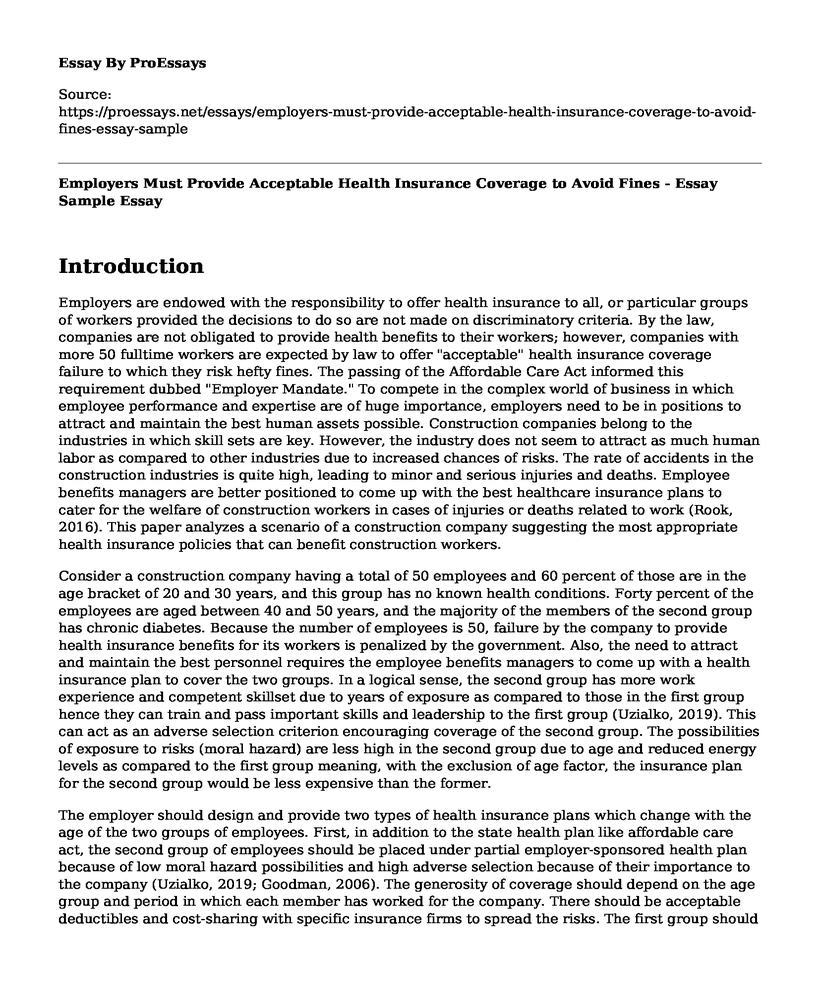Introduction
Employers are endowed with the responsibility to offer health insurance to all, or particular groups of workers provided the decisions to do so are not made on discriminatory criteria. By the law, companies are not obligated to provide health benefits to their workers; however, companies with more 50 fulltime workers are expected by law to offer "acceptable" health insurance coverage failure to which they risk hefty fines. The passing of the Affordable Care Act informed this requirement dubbed "Employer Mandate." To compete in the complex world of business in which employee performance and expertise are of huge importance, employers need to be in positions to attract and maintain the best human assets possible. Construction companies belong to the industries in which skill sets are key. However, the industry does not seem to attract as much human labor as compared to other industries due to increased chances of risks. The rate of accidents in the construction industries is quite high, leading to minor and serious injuries and deaths. Employee benefits managers are better positioned to come up with the best healthcare insurance plans to cater for the welfare of construction workers in cases of injuries or deaths related to work (Rook, 2016). This paper analyzes a scenario of a construction company suggesting the most appropriate health insurance policies that can benefit construction workers.
Consider a construction company having a total of 50 employees and 60 percent of those are in the age bracket of 20 and 30 years, and this group has no known health conditions. Forty percent of the employees are aged between 40 and 50 years, and the majority of the members of the second group has chronic diabetes. Because the number of employees is 50, failure by the company to provide health insurance benefits for its workers is penalized by the government. Also, the need to attract and maintain the best personnel requires the employee benefits managers to come up with a health insurance plan to cover the two groups. In a logical sense, the second group has more work experience and competent skillset due to years of exposure as compared to those in the first group hence they can train and pass important skills and leadership to the first group (Uzialko, 2019). This can act as an adverse selection criterion encouraging coverage of the second group. The possibilities of exposure to risks (moral hazard) are less high in the second group due to age and reduced energy levels as compared to the first group meaning, with the exclusion of age factor, the insurance plan for the second group would be less expensive than the former.
The employer should design and provide two types of health insurance plans which change with the age of the two groups of employees. First, in addition to the state health plan like affordable care act, the second group of employees should be placed under partial employer-sponsored health plan because of low moral hazard possibilities and high adverse selection because of their importance to the company (Uzialko, 2019; Goodman, 2006). The generosity of coverage should depend on the age group and period in which each member has worked for the company. There should be acceptable deductibles and cost-sharing with specific insurance firms to spread the risks. The first group should have affordable care and consumer-driven health plan because of the high tendencies of exposure to risks and minimum adverse selection (Owen, 2009). These plans should be well explained to the employees, and they should also be invited to take an active part in their health affairs (Tarrell, n.d.).
Conclusion
In conclusion, healthcare insurance plans are central in ensuring that employee affairs are catered for and also shows them that they are cared for by their employers. Managers should have a comprehensive knowledge of the state and federal requirements as far as insurance covers are concerned. Above all, partnerships with appropriate insurance firms and the financial muscle of the construction company should determine the health plans suitable for the workers for the long term.
References
Goodman, J. (2006). Employer-Sponsored, Personal, And Portable Health Insurance. Health Affairs, 25(6), 1556-1566. doi: 10.1377/hlthaff.25.6.1556
Owen, C. (2009). Consumer-Driven Health Care: Answer to Global Competition or Threat to Social Justice?. Social Work, 54(4), 307-315. doi: 10.1093/sw/54.4.307
Tarrell, A. Choosing the Right Consumer-Driven Health Plan. Retrieved from https://www.hni.com/blog/bid/77411/choosing-the-right-consumer-driven-health-plan
Rook, D. (2016). Employee Benefit Considerations for The Construction Industry. Retrieved from https://www.griffinbenefits.com/employeebenefitsblog/employee-benefits-for-the-construction-industry-blog
Uzialko, A. (2019). How Do You Offer Health Insurance?. Retrieved from https://www.businessnewsdaily.com/12017-how-do-you-offer-health-insurance.html
Cite this page
Employers Must Provide Acceptable Health Insurance Coverage to Avoid Fines - Essay Sample. (2023, Jan 22). Retrieved from https://proessays.net/essays/employers-must-provide-acceptable-health-insurance-coverage-to-avoid-fines-essay-sample
If you are the original author of this essay and no longer wish to have it published on the ProEssays website, please click below to request its removal:
- Essay on Public Health: The Impact of Society on Health of the Individual with Fibromyalgia
- Incorporating the Evidence in Data-Driven Decision Making Essay
- Essay Sample on Personal Reflection on Dementia
- Tuberculosis: A Global Health Crisis - Essay Sample
- COVID-19 and African Americans in NYC: Tough Times, Tough Measures - Essay Sample
- Staffing Struggles: An Examination of MCW's Employee Records - Essay Sample
- Technology in Australia During COVID - Report Sample







